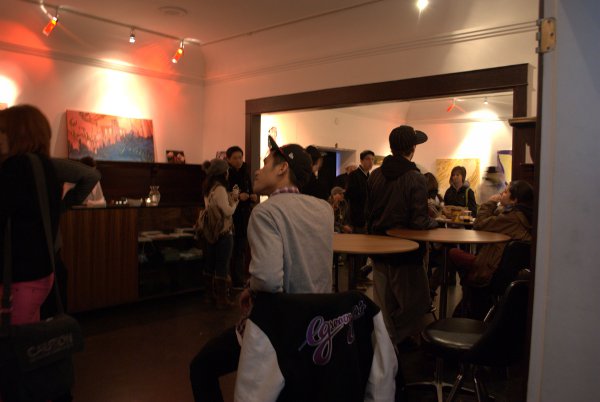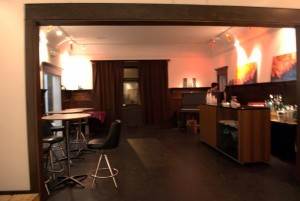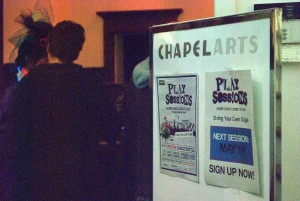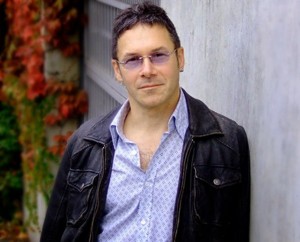Chapel Arts, an unorthodox use of a chapel
February 28, 2011 by Sarah Casimong · Leave a Comment
Despite being a chapel, Chapel Arts has nothing to do with worship unless the subject of praise is the art displayed throughout the building.
When Chapel Arts first opened as a venue three years ago, the words on the window read: “If nothing else believe in art.”
“I’m just not religious,” said Nathan Wiens, owner of Chapel Arts. “I was raised in a family filled with artists and stuff, so I guess that’s what I believe in. I believe in makers instead of The Maker.”
What was once known as the Armstrong Funeral Chapel was owned by the Armstrong family for 103 years, according to Wiens. He bought the chapel in 2005, in what he calls “an accident.”
While searching for a space to make art and furniture, Wiens found a building across the street from the chapel. He was forced to buy the chapel in order to get the shop, as the two buildings had to be bought together. His intial intention was to sell the chapel, but he soon fell in love with its charm and set out to get a licence from the city to open it as a venue.
“That was a very long, educational process,” said Wiens. “[It] took about 22 months to get a licence from the city of Vancouver. They’re very strange. Bureacracy is a very strange thing.”
He claims it was the biggest challenge he faced.
“It cost as much money to wait for them as it cost to buy the real estate. It’s a long time to hustle for a simple business licence that isn’t a change of use but they decide to make it one. So it’s sort of disappointing.”
Once he got the chapel, Wiens renovated it as if it was still 1936, when the chapel’s was expanded, in order to keep its historical feel.
Since getting the licence, the chapel’s been successfully hosting events that include performance art, theatre, concerts, government meetings, conferences, workshops and movie work.
He compares the chapel to “a house party” when it hosts events. The chapel makes most of its money hosting family and corporate parties.
“I believe that everyone’s living in very small places so having an intimate venue like this, that has a homey feel, is kind of attractive to people.”
Although the unorthodox use of space and cozy feel attracts people, being located in the Downtown Eastside turns some people away but Wiens says that’s not always a bad thing.
“The neighbourhood’s a bit tough, but I like the neighbourhood, I don’t have a problem with it. It keeps a lot of people that wouldn’t really appreciate the place away. So it’s a self-screening process. But it keeps a lot of money way, so it’s a bit of both, there are pros and cons.”
Despite the cons, he manages to appreciate the history that comes with the chapel and the neighbourhood it’s a part of.
“It’s a bit tough in just this zone but I don’t think that will change,” said Wiens. “I think the ratios of the demographics will change. There will be less low-income housing in this neighbourhood in the future. It’s the oldest part of the city. It’s the beginning of Vancouver right here. This is where Vancouver started, right here.”
He has high hopes for the chapel and what it will continue to contribute to the Vancouver’s art community.
“I think it will just increase in success with the community,” said Wiens. “I think it’s gonna, whether it’s me running it or not, it’s gonna be around a long time as a public venue that will probably have a good arts base to it. I hope to hang onto it but one never knows.”
Visit chapelarts.com more information.
Pi Theatre: Blending local and international artists in one production
February 27, 2011 by Meagan Gill · Leave a Comment
In a society where everyone is consumed by some kind of electronic device, sitting down in a theatre with a group of strangers to watch a play is the ultimate communal experience.
“It’s about the people your sitting beside, breathing the same air as the people on stage, sharing the same moments at the same time and influencing each other,” said Richard Wolfe, artistic director of Pi Theatre. “You can tell when someone is feeling tense about a moment, you can kinda sense it. I think the more digitized society becomes, the more important that kind of contact will be.”
Wolfe describes a recent bus ride, where practically everyone was looking down at their phone texting or listening to their iPod, not really paying attention to all of the people that surround them. He says people become engaged in these devices but that theatre is all about human interaction and communication.
Wolfe has always had a love for theatre and an interest in human communication. “Theatre is really all about human interaction, human challenges, aspirations and family. It’s a formalized portrayal of human life.”
Pi Theatre is an independent theatre company located in Vancouver. It produces local and international contemporary plays that are dynamic, exciting and provocative. Wolfe has been the artistic director of Pi Theatre for three years. Before that, he was the co-founder, director and co-artistic producer of Theatre Conspiracy for 12 years.
Theatre Conspiracy was similar to Pi Theatre in the way that they both look at international artists, as well as local. They did Canadian premieres of many major international plays, which include Wil Eno’s Thom Pain, Penhall’s Blue/Orange and Jez Butterworth’s Mojo. He chose to leave Theatre Conspiracy and become the artistic director of Pi Theatre because funding was more stable. At Theatre Conspiracy, they were paid project-to-project whereas at Pi Theatre, his job is salary-based.
Wolfe has received 30 nominations for Outstanding Artistic Achievement for his productions in Vancouver. He won two awards, for Outstanding Ensemble Cast, and has been nominated for Outstanding Director three times.
Wolfe got his MFA at UBC. He says his inspiration comes from his teachers, well-established artists, and from the people he works with. “Everybody that you come into contact with at different points in your life will have an impact on you in one way or another.”
He describes Vancouver’s theatre scene as healthy because there are a lot of creative artists here and schools that offer theatre programs. “People are being trained, and they’re being put into the community and all of that energy produces good things,” said Wolfe.
According to Wolfe, the biggest challenge facing independent theatre companies is funding.
“The provincial government isn’t pulling their weight but the current administrative of the city is very pro-arts and culture because they understand that the creative economy is essentially important in the larger economic picture,” he said. “But with the provincial government, after arts and culture played such a huge role in the Olympics, coincidently or not, right after the Olympics were over, they cut all the funding.”
He says his long-term goal for Pi Theatre is to increase the programming and keep it in a financially stable position. He also wants to continue building its profile as a playwright-centred theatre company that deals with the best contemporary playwrights.
To Wolfe, the most important thing in theatre is to “look at the world we live, in a very strong and individual way that speaks to the audience, whether they’re from here or not,” he said. “Certainly it’s important to develop local writers and to juxtapose those writers and the plays they write with international plays so that we can have a bigger picture of the world and of the art.”
To learn more about Pi Theatre, visit the website.
Cuban exchange teaches more than academics
February 27, 2011 by Jeffrey Yip · Leave a Comment
Alexis Wiessler believes we have a lot to learn from Cuba.
Wiessler, a horticultural student, was one of six students who went to Cuba in October 2010, through an exchange program with the Institute for Sustainable Horticulture, to participate in field research at the University of Sancti Spiritus.
“I just thought going to Cuba and seeing how they do things would be really beneficial to my career further down the road,” she said.
Cuba is a leader in sustainable farming practices, which is using more environmentally friendly techniques to grow crops. Wiessler and some of her colleagues worked on a project using a fungus to fight different plant diseases. They also used plants to attract insects that are natural enemies of other insects that are harmful to crops.
Overall, she believed the research went well, but they did have some problems.
“There were always pigs and goats and turkeys in the fields eating everything,” she said.
For the 26-year-old, the exchange became more than just about sustainable farming. While she knew living in Cuba would be difficult, nothing could have prepared her for just how different things would be. Cramped living quarters and little variety of food were just a couple of the challenges she faced.
It was her brief glimpse into the lives of everyday Cubans that Wiessler will remember most. She said that despite the hardships the Cubans faced every day, they are still a happy, friendly people who appreciate what little they do have.
“It was really refreshing to see people who have so little just not being affected by it that much,” she said.
The biggest challenge for Wiessler was living in a socialist country. She said things we take for granted, such as freedom of speech, don’t happen in Cuba.
“It was kind of scary at times, because we didn’t really know if we were overstepping any bounds,” she said.
As difficult as the exchange was at times, Wiessler doesn’t regret going and encourages other students to go on similar exchanges and keep an open mind about new experiences.
“I always knew we were lucky in North America, but it’s totally a different thing living in another country and really see how lucky we are,” she said. “As hard as it was, I miss it a lot. I started to get really comfortable there.”
Students air their feelings about stress
February 27, 2011 by Stu Gallacher · Leave a Comment
It’s that time of the semester when papers and mid terms start to pile up — and there’s no shortage of grievances to go along with them.
The academic system isn’t perfect and venting is a good way to release stress. Kwantlen students were asked what they find most frustrating about school.
Just Tillyer, 21, who studies psychology, said that he’d like to see more short- and long-answer tests, instead of multiple choice quizzes.
“It would be nice if there was more opportunity in terms of testing where students were expected to explain things,” said Tillyer.
Tillyer said he prefers written exams, so he can demonstrate in depth his grasp of the material.
Kim Blik, 22, who is in general studies, said mid-terms are her biggest stress. “Having [several] mid-terms on the same day is really stressful…and balancing work with school to pay the bills,” said Blik.
Students have different ways of coping with the stresses of school, finding some things more frustrating than others.
“Some profs hand out work that’s irrelevant to the classes. Some of the workload is just too much. Other than that, there’s nothing about school I really find bothersome. It’s just time consuming,” said Amar Badh, 19, who’s in general sciences.
Shane Kubeska, 21, who studies criminology, said he gets frustrated when teachers put emphasis on parts of the course that don’t appear on the exam. “Whatever is emphasized most on the exam should be emphasized in the lectures, so we know what to study.”
Kubeska said that he studies all the notes from class, but when there’s so much to cover, teachers should point out what the most important material is.
Lack of funding shuts down Eagles baseball program
February 27, 2011 by Josh Saggau · 1 Comment
After a disappointing 2009-’10 season, the Kwantlen Eagles baseball program has folded this season.
“The baseball program operated as a club team, therefore it was a self-sustaining program. Although the university provided funds to assist the team in completing its final year, the club was unable to sustain itself financially,” athletics director Elise Le Brun wrote in an email.
The difference between a club team and a varsity team — the basketball and soccer teams are varsity teams — is funding. The baseball team was essentially paying its own way to play. While Kwantlen did contribute some funds to assist the team, it far less than the funding received by Kwantlen’s basketball program.
“The first year I was there, we got a little bit [of funding] and then the second we got even less. It was ridiculous. We almost couldn’t even finish our season the second year because we had no money,” said last season’s catcher Colton Mace.
The program also suffered as a club team in its recruitment of players and the team had just 15 players on its roster last season.
“You get no money, no nothing. You have to pay money out. You’re not going to get a lot of people playing that way,” said Mace.
With plenty of other Premier-level baseball teams, such as the Langley Blaze, in the Lower Mainlaind it was hard to convince athletes to come to Kwantlen.
While both the Eagles and Blaze are self-funded organizations, since 2001, the Blaze have had 26 players drafted by Major League teams. The Eagles have had just two: shortstop Lee Darracott and pitcher Chirs Lemay, both in 2004.
The Eagles did have some success in the early years of the program, including a Canadian College Baseball Conference Championship in 2003, but funding and recruitment difficulties eventually caught up with the team last season. They finished the ’09-’10 season with a 4-20 record and didn’t have a single player hit better than .275 for the season.
Le Brun wrote that “the club was unable to sustain itself financially. Therefore, the club administration made the decision to discontinue its support of the team in April 2010.”
Mace saw the decision a little differently.
“Rob [Webster], the coach, was supposed to get paid but because the school didn’t support it he had to get another job and he just didn’t have time for it. And there were no more guys that wanted to play.”
Kwantlen Eagles vs. Douglas Royals
February 18, 2011 by Lucas Meneses-Skoda · 1 Comment
Tune in to live coverage as your Kwantlen Eagles face off against the Douglas Royals. Josh Saggau and Lucas Meneses-Skoda bring you the Women’s game live at 6 and the Men’s at 8. Catch it all here:
NOTE: When the player first launches, you will be subjected to a short ad. The audio play-by-play will commence after the ad ends.
GDMA student uses her Kwantlen education at national paper
February 17, 2011 by Kyle Benning · Leave a Comment

Cat Yelizarov with some of her school work. Yelizarov thinks that being a student is more stressful than working at a national paper. (Photo by Kyle Benning)
Cat Yelizarov spent her past summer as few other university student did: working in the stress-filled environment of a newsroom.
The fourth-year GDMA (Graphic Design for Marketing) student at Kwantlen spent the summer completed her internship at the Globe and Mail newspaper in Toronto.
Yelizarov went into her internship with only a little journalism experience, from working with The Runner, the student-run newspaper at Kwantlen.
Yelizarov said going to Toronto by herself to work as an intern was difficult and scary.
“It was different because I came with no journalism background, so I had no experience and I was really scared, and every day I thought I was going to get fired because I thought I sucked,” Yelizarov said.
In Toronto, Yelizarov was thrown straight into designing for the Globe and Mail. She was given two days of training and then she was designing section fronts.
What made her experience even more stressful was the Globe and Mail was in the process of redesigning the newspaper while she was there. Yelizarov was in charge of designing multiple section fronts each day, as more experienced designers were helping out with the redesign or on vacation.
Yelizarov ended up designing a front for every section of the Globe and Mail during her time there, except for the Report on Business section. She said her time there was stressful, but still thinks school is more pressure packed then working.
“I think it’s way more stressful being in school than working for a national newspaper. There is way more pressure,” Yelizarov said. “It’s weird because you’re responsible for designing, and the [printing] plates cost so much, like $1,000 per front, and if you fuck it up that’s like thousands of dollars down the drain because they have to fix it.”
But at university, she said that the pressure of getting good grades and peer pressure is worse.
Working under pressure is something Yelizarov thinks she does well, and that helped her keep focused, even with daily deadlines — and when mistakes were made.
“I spelled the person’s name wrong for a Saturday front which is horrible. So horrible,” Yelizarov said.
Dealing with mistakes and the pressure of deadlines wasn’t even the most challenging thing Yelizarov faced during her time at the Globe and Mail. It was some of the people she had to deal with.
The Globe and Mail is unionized and she says that while many people she worked with were cooperative and good-natured, others were there because of the pay and were bitter.
“You have to deal with people that would duck when they see the section editor because they didn’t want to talk to them. They would avoid them. You have a deadline at four and you’re avoiding the section editor, so it was complete chaos,” Yelizarov said.
With graduation and a wedding coming up, and the need to find a job, Yelizarov looks to be just as stressed as she was last summer. But after her experience at the Globe and Mail, she feels like she can accomplish anything.

Yelizarov's final project was her redesign of the R View newspaper. She redesigned the paper last year and set up a template for them to use. (Photo by Kyle Benning)
Food for Fines aims to help hungry students
February 17, 2011 by Jeffrey Yip · Leave a Comment
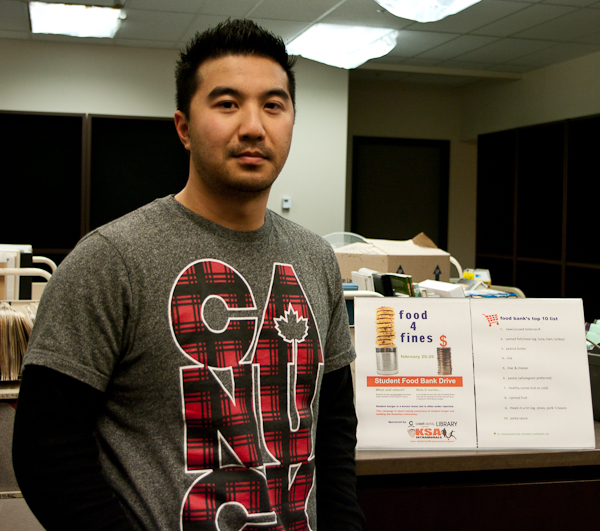
KSA Health & Recreation Manager, Eddie Lee, hopes the Food for Fines drive from Feb. 20-26 will give students incentive to donate to the food bank. Photo by Matt Law.
The KSA has partnered with the Kwantlen library to raise awareness about student hunger and generate donations for the KSA food bank.
“We wanted to provide incentive for them to donate. At the same time we wanted them to recognize that other students are in need and that they can really help and make a difference,” said Eddie Lee, KSA health and recreation manager.

A lack of donations have forced the KSA to spend students' money to fill the demands of the the food bank. (Photo by Matt Law.)
The Food for Fines program, Feb. 20-26, allows students to bring in non-perishable food items or new or unused toiletries to any campus library and receive $2 off fines for overdue items, up to a maximum of $10.
Lee got the idea from other universities that have had success with similar programs.
According to Lisa Hubick, public relations librarian, the library was happy to participate. She said the library had a history of helping local community food banks, but this was the first time they will be able to directly help out Kwantlen students.
While she admits that fines aren’t a huge problem with Kwantlen students, she hope students will take advantage of the Food for Fines program and help out fellow students.
Currently, the KSA food bank buys most of the food they need. According to Lee, they spend about $500 a semester on food bank supplies.
“The idea was to tug at the heart strings a little bit, as opposed to just doing a regular food drive,” Lee said of the program.
For more information on the food bank visit http://kwantlen.weebly.com/student-food-bank.html.
Slideshow: local filmmakers bring Dungeons & Dragons to life
February 17, 2011 by Amanda Punshon · 2 Comments
Photos and audio from the filming of Standard Action episode four at the Fish House restaurant in Stanley Park, Vancouver on Jan. 31. The series, created by local actor Joanna Gaskell, takes place in the universe of a role-playing game similar to that of Dungeons & Dragons. Episodes one through three are online now.
The Giggle Guide: where to find improv and standup comedy nights in the GVRD
February 16, 2011 by Amanda Punshon · Leave a Comment
New York, Boston, Chicago and Montreal are all funny cities. Together, they have produced some of the biggest names in comedy — instantly recognizable people such as Jon Stewart, Conan O’Brien, Bonnie Hunt and Caroline Rhea.
But what about Vancouver?
While it’s true that we are not as well-known for our comedy scene as Just For Laughs staples such as Montreal, Vancouver does have a pretty solid comedy scene. Colin Mochrie (Whose Line is it Anyway, This Hour Has 22 Minutes,) Ryan Stiles (the Drew Carey Show, Two and a Half Men,) and Seth Rogen (Freaks and Geeks, Superbad) are all from here, and local and international comedians play Vancouver’s comedy and nightclubs every week. Show tickets are usually cheaper than the latest 3-D Justin Beiber cinematic extravaganza, and most of the venues are licensed.
The only problem is that finding comedy nights in Vancouver isn’t easy. That’s why we’ve created the Giggle Guide. Simply pick the night you want to go out and click through the available options to see what’s happening. Clicking the map for a venue will take you to the Google Maps website, where you can get more detailed directions.
A caveat: Vancouver’s comedy scene is like a beach. New things are always washing up as the old drift away, making it impossible for this guide to be comprehensive. It’s always a good idea to phone the venues before heading out, just in case they’ve changed or cancelled their night. Most venues are 19+.
*The Montemartre Cafe has comedy nights once a month; Zesty’s Restaurant occasionally hosts comedy events.
Infographic by Amanda Punshon and Sarah Casimong

